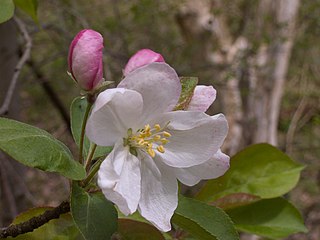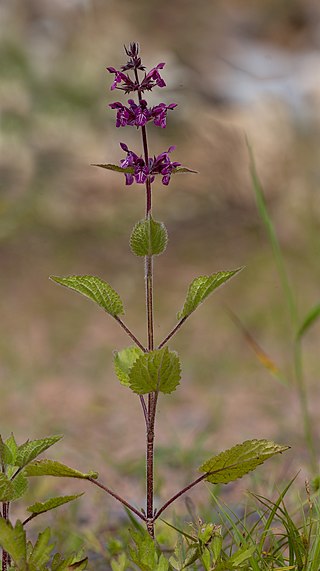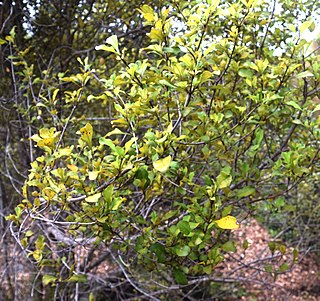
Aralia spinosa, commonly known as devil's walking stick, is a woody species of plant in the genus Aralia, family Araliaceae, native to eastern North America. The various names refer to the viciously sharp, spiny stems, petioles, and even leaf midribs. It has also been known as Angelica-tree.

Malus coronaria, also known by the names sweet crabapple or garland crab, is a North American species of Malus (crabapple).

Stachys sylvatica, commonly known as hedge woundwort, whitespot, or sometimes as hedge nettle, is a perennial herbaceous plant growing to 80 cm (31 in) tall in woodland and unmanaged grassland. In temperate zones of the northern hemisphere it flowers in July and August. The flowers are purple. The leaves, when crushed or bruised, give off an unpleasant fetid smell.
Viburnum elatum is a species of woody plant in the family Adoxaceae. It is endemic to eastern Mexico.

Cestrum diurnum is a species of Cestrum, native to the West Indies. Common names include day-blooming cestrum, day-blooming jessamine, and day-blooming jasmine. Also known as Din ka Raja, in Urdu and Hindi. The scent of this quick-growing and evergreen woody shrub, often used for screens and borders, is released by day. Cestrum diurnum is easily propagated from the seed, which it produces in abundance.

Coprosma arborea is a species found in New Zealand, traditionally known in Māori by the name mamangi. The flowers have insignificant petals and are wind pollinated, with long anthers and stigmas. The fruit is a non-poisonous juicy berry, containing two small seeds. A typical occurrence location of the species is in the Hamilton Ecological District in New Zealand's North Island.

Brunfelsia latifolia, commonly known as yesterday-today-tomorrow and kiss me quick, is a species of flowering plant in the nightshade family. Endemic to Brazil, it is an evergreen shrub that becomes semi-deciduous in cooler areas and grows up to 1.8 meters in height.

Solanum evolvuloides is a species of Solanum, which was first described in 2011 by Giacomin & Stehmann. Solanum evolvuloides belongs to section Gonatotrichum, a small group assigned to the Brevantherum clade of the genus Solanum. It resembles Solanum turneroides Chodat, sharing with it heterandry, and Solanum parcistrigosum Bitter, with which it shares a similar habit and pubescence. Despite these similarities, the species can be recognized by its ovate-elliptic to cordiform leaf shape and more membranaceous leaf texture than the other species in the section, and stem, inflorescence axes, and calyx vestiture mainly composed of glandular hairs. Solanum evolvuloides is known to occur only in southeastern of Bahia state, Brazil, and in a preliminary assessment of the International Union for Conservation of Nature (IUCN) criteria can be considered a threatened species.

Leucas aspera is a plant species within the genus Leucas and the family Lamiaceae. Although the species has many different common names depending on the region in which it is located, it is most commonly known as Thumbai or Thumba. Found throughout India, it is known for its various uses in the fields of medicine and agriculture.

Coprosma rotundifolia is a native forest shrub of New Zealand found on the North, South, and Stewart Islands.
Lippia substrigosa is a plant from the family Verbenaceae that is native to Central and South America. It can grow as either a shrub or a tree up to 7 metres (23 ft) tall and can be burned to produce fuel. Its essential oil may have pharmaceutical or cosmetic uses.

Coprosma acerosa, commonly called sand coprosma, is a shrub that is native to New Zealand. It is a coastal plant found on the landward side of sand dunes. C. acerosa is a low, spreading shrub with yellow-brownish leaves, red bark and blue fruit.

Globularia salicina is a shrub native to the archipelago of Madeira and to the central and western Canary Islands.

Karomia speciosa is an African deciduous large shrub or bushy tree up to 7 m, and relocated to the family Lamiaceae from Verbenaceae. It is one of 9 species in the genus Karomia, a genus containing species previously classified in Holmskioldia, and is closely related to Clerodendrum. The only remaining species in the genus is Holmskioldia sanguinea, occurring in the foothills of the Himalayas.

Stephanotis volubilis, synonyms including Dregea volubilis, is a species of plant in the family Apocynaceae that is native from north-east Pakistan eastwards to south China and southwards to Java.

Lepanthes kokonuko is a species of orchid from southern Colombia. L. kokonuko can be easily recognized by its caespitose medium-sized plants, elliptical coriaceous leaves, long loosely, flexuous and distichous inflorescences; strongly revolute lateral sepals, transversely bilobed petals with the upper lobe lanceolate (hornlike), and a bilaminate lip with the blades ovoid–lanceolate with a bipartite appendix.

Hibiscus mesnyi is a deciduous, riverine, tropical forest tree, endemic to Vietnam, in the family Malvaceae.
Hoffmannanthus is a monotypic genus of flowering plants in the Asteraceae. There is only one known species, Hoffmannanthus abbotianus(O.Hoffm.) H.Rob., S.C.Keeley & Skvarla Its native range is Uganda and southern Tropical Africa. It is found in the countries of Angola, Kenya, Tanzania, Uganda, Zambia and Zaïre.

Dudleya cymosasubsp. cymosa is a species of succulent perennial plant in the family Crassulaceae native to California. It is the autonymous subspecies for Dudleya cymosa, and is known by the common name canyon liveforever. It is native to the California Coast Ranges, the Sierra Nevada and the Santa Monica Mountains. It is characterized by bright-yellow, orange or red flowers and broad, wide leaves. This plant is commonly found growing on rocky outcrops, talus slopes, and in shaded canyons.
Lonicera kawakamii, also known as Yushan honeysuckle or Kawakami’s honeysuckle, is a species of flowering plant in the family Caprifoliaceae. It is endemic to Taiwan, where it is found at altitudes between 3000 and 3900 meters. It as rated as “Vulnerable” in the “Red List of Vascular Plants of Taiwan, 2017”.
















